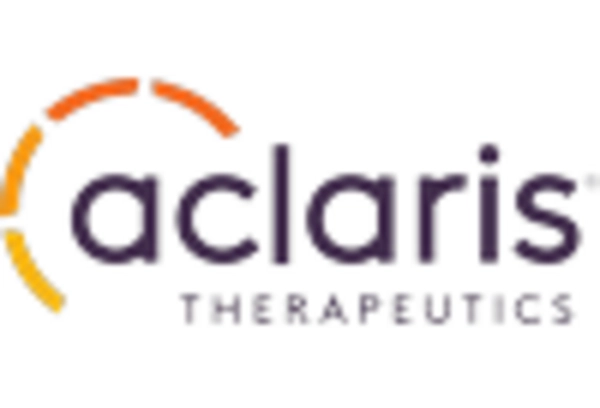Changing Lifestyle Factors
Changing lifestyle factors are playing a crucial role in shaping the alopecia drugs market. Increased stress levels, poor dietary habits, and environmental factors are contributing to a rise in hair loss among various demographics. Studies suggest that lifestyle-related hair loss is becoming more common, particularly among younger populations. As awareness of these factors grows, individuals are more likely to seek medical advice and treatment options. The US market is witnessing a shift in consumer behavior, with a growing preference for effective and convenient treatment solutions. This trend is likely to drive demand for alopecia drugs, as patients look for ways to mitigate the effects of lifestyle-induced hair loss. Consequently, the alopecia drugs market is expected to expand as more individuals seek remedies for their hair loss concerns.
Advancements in Pharmaceutical Research
Recent advancements in pharmaceutical research are propelling the growth of the alopecia drugs market. Innovative drug formulations and delivery mechanisms are being developed, which may enhance the efficacy of treatments. For instance, the introduction of biologics and targeted therapies has shown promise in clinical trials, potentially leading to new treatment options for patients. The US market has seen a surge in investment, with research funding increasing by approximately 15% over the past few years. This influx of capital is likely to accelerate the development of novel therapies, thereby expanding the range of available options for individuals suffering from alopecia. As a result, the alopecia drugs market is poised for substantial growth in the coming years.
Rising Incidence of Autoimmune Disorders
The rising incidence of autoimmune disorders is emerging as a significant driver for the alopecia drugs market. Conditions such as alopecia areata, which is an autoimmune disease that causes hair loss, are becoming more prevalent. Recent studies indicate that autoimmune diseases affect nearly 24 million people in the US, with a notable percentage experiencing hair loss as a symptom. This trend is likely to increase the demand for effective treatments, as patients seek solutions to manage their conditions. The growing recognition of the link between autoimmune disorders and hair loss is prompting healthcare providers to explore new therapeutic options, thereby stimulating the alopecia drugs market. As awareness continues to grow, the market may see an influx of innovative treatments tailored to this demographic.
Growing Awareness of Hair Loss Conditions
The increasing awareness of hair loss conditions among the population is a notable driver for the alopecia drugs market. Educational campaigns and social media discussions have contributed to a heightened understanding of alopecia, leading to more individuals seeking treatment options. In the US, it is estimated that approximately 35 million men and 21 million women experience some form of hair loss, which underscores the potential market size. This awareness not only drives demand for existing treatments but also encourages pharmaceutical companies to invest in research and development of new drugs. As more people recognize the psychological impact of hair loss, the willingness to seek effective solutions is likely to grow, thereby expanding the alopecia drugs market significantly.
Increased Investment in Dermatological Research
Increased investment in dermatological research is significantly influencing the alopecia drugs market. Pharmaceutical companies are recognizing the potential profitability of developing treatments for hair loss, leading to a surge in funding for research initiatives. In the US, dermatology research funding has increased by over 20% in recent years, reflecting a growing interest in addressing hair loss conditions. This financial commitment is likely to result in the discovery of new drugs and therapies that cater to the diverse needs of patients. As the market evolves, the introduction of novel treatments may enhance patient outcomes and satisfaction, thereby driving further growth in the alopecia drugs market. The focus on dermatological advancements is expected to yield promising results in the near future.

















Leave a Comment